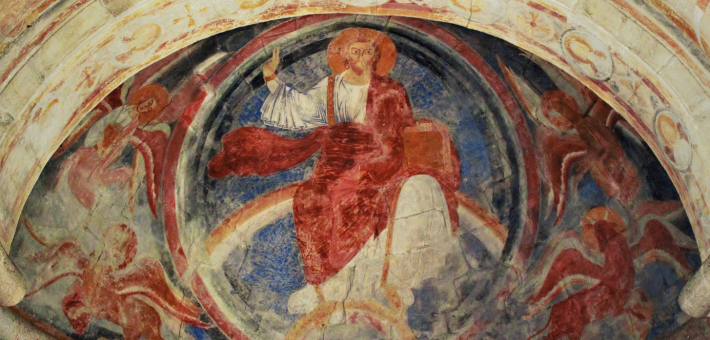Commentary on Matthew 25:31-46
The Lord’s teaching on the final judgment challenges every disciple of Jesus to be a harbinger of God’s kingdom in a broken world.1
The teaching opens with apocalyptic images that convey Christ’s kingship. The image of the Son of Man coming in glory reflects imagery from Daniel 7:13-14 and recalls other places in Matthew’s Gospel where Jesus foretells the coming judgment (24:30-31; 26:64).
In chapter 24, after Jesus privately warns his disciples of dark days ahead when false prophets will arise and many will lose faith, Jesus tells his followers that the suffering will be interrupted by “the Son of Man coming on the clouds of heaven with power and great glory” (24:30). He will send out his angels to gather all the elect (24:31). In the passage under study, which marks the end of Jesus’ eschatological discourse (24:1-25:46), the Son of Man has arrived with his angels and is now seated on the throne, where he is called the king (25:34).
The portrait of Christ as King is a fearsome one in this text. All the nations of the world have gathered before him and behold his majesty. This imagery recalls Zechariah 14:1-21 where every nation will recognize the kingship of the Lord as the Lord stands upon the Mount of Olives—Jesus’ own location as he teaches his disciples (Matthew 24:3).
From the throne, the king uses his authority to separate the people. To illustrate the separation of one individual from another, Jesus likens himself to a shepherd who separates his flock of sheep from the goats who are grazing in the same pasture. The sheep receive the place of honor and inherit God’s kingdom (25:34).
Jesus calls the sheep those who are “blessed by my Father” (25:34). Who are the blessed ones? The blessings of the beatitudes foreshadow Jesus’ eschatological teaching. Although the Greek word for “blessed” in 25:34 is not the same as the one employed in the beatitudes, both convey a blessing from God.
In the beatitudes, Jesus blesses those who are persecuted for righteousness’ sake and who are reviled for their faith (5:10-11; cf. 24:9-14). Likewise, Jesus’ teaching on the blessing of the sheep comes after he has warned his disciples that they will be hated by the world and tortured for his sake (24:9). In Christ’s kingdom, the blessed ones are those who do not retaliate with violence, but bear witness to a new empire by serving others (25:31-46).
The blessed ones have demonstrated their faithfulness by performing acts of loving-kindness. The charge to care for the poor and the disadvantaged can be found throughout scripture, but it is especially exhibited in the ministry of Jesus. In this Gospel, Christ has announced the arrival of God’s kingdom while he cures the sick (e.g., 8:28-9:8, 9:18-38; 12:9-14; 14:34-36; 15:29-31), welcomes the despised (9:9-13), and provides food for the hungry (14:13-21; 15:32-39). He orders his disciples to carry on his ministry by doing likewise (10:5-15, 40-42).
The service of the “least” concerns all people everywhere. Since Jesus has warned the disciples repeatedly of their upcoming persecution (10:16-39; 24:9-14), the context of this passage suggests that believers would certainly be among those who are suffering and imprisoned.
The primary purpose of a prison at the time was not to incarcerate individuals for an indefinite period of punishment, but to have a place for them to await trial (consider Philippians 1:19-20; 2:23-24). It was often the responsibility of loved ones to provide some basic necessities while the person was in jail. Not only are believers to provide this service for one another, but they are to demonstrate Christ’s love by ministering to others who may have no one to care for them.
The righteous ones performed these deeds with no idea that they were ministering to Christ. Jesus says that whenever they gave food to the hungry, welcomed a stranger, clothed the naked, or visited the sick or imprisoned, they acted in kindness toward Jesus himself. Jesus can identify with the least of these because he has walked in their shoes (cf. 8:20).
On the other hand, those who have failed to see the needs of the disadvantaged have acted as though they have never seen Jesus. They have not followed in Christ’s footsteps. They have not continued to do the work that the Master has called them to do (24:45-51). They have not displayed who the real King is.
Throughout the Gospel of Matthew, Jesus’ teaching has announced and illustrated the kingdom of God. God’s kingdom does not function like a typical kingdom. This divine reign has invaded the world and is good news—especially to those on the fringes of society. This rule welcomes those who have no status and seeks to serve others rather than exploit them.
The righteous have inherited this kingdom. Those who claim to follow Jesus and hope to endure to the end (24:13) are called to live faithfully to God’s righteous empire.
Those who have experienced God’s kingdom cannot go back to life as it once was. Stanley Hauerwas writes, “The difference between followers of Jesus and those who do not know Jesus is that those who have seen Jesus no longer have any excuse to avoid ‘the least of these.'”2
The blessed ones are those who have seen a King who is not like the kings of this world. They are blessed because they know a King who brings real peace, who sees the needy, and who hears the cries of the oppressed. In God’s kingdom, no one is hungry, naked, sick, or alone. To bear witness to Christ as King is to be a messenger of this kingdom—to serve others and thereby profess the invasion of God’s glorious empire.
Notes
- Commentary first published on this site on Nov. 20, 2011.
- Stanley Hauerwas, Matthew (Brazos Theological Commentary on the Bible; Grand Rapids: Brazos Press, 2006), 211.



November 26, 2023